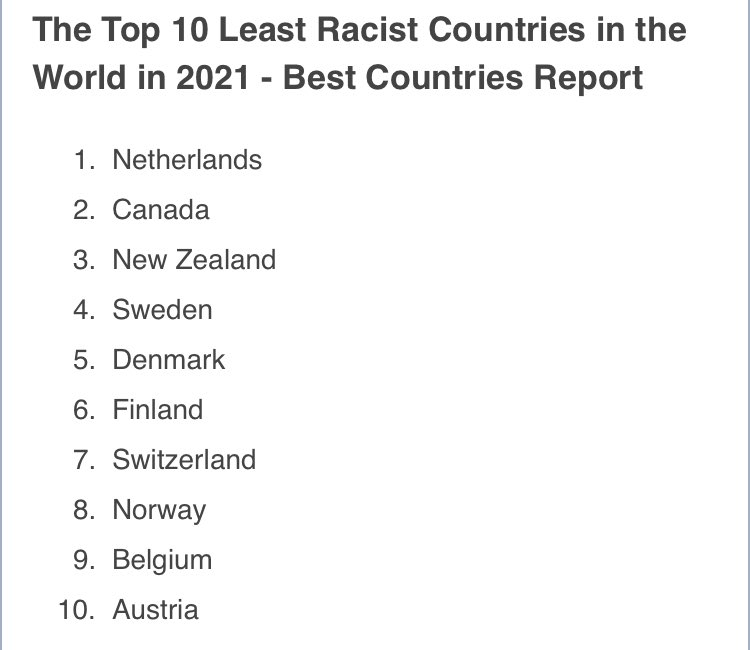Some of my best friends are…
Circulating on Twitter, but originally from US News and World Report
It’s an interesting list.
Most of the people talking about it on Twitter wanted to ridicule the list without actually worrying about how it was constructed, so it didn’t come with any link or any explanation beyond the source. It’s not hard to find some information, although I haven’t been able to get full details.
There are different ways you might go about constructing a ‘racism’ ordering for countries. According to a 2013 story in the Washington Post, one ranking of basically this sort started with a question in the World Values Survey. Two researchers (I’ll let your prejudices work by saying they were Swedish economists) wanted to look at relationships between economic freedom and racism. They needed something widely measured, and used a question about kinds of people you would not be happy with having as neighbours. One of the options was “people of a different race”, others include “people with AIDS”, “immigrants”, “heavy drinkers”, “unmarried couple living together”, “people of a different religion” and so on. These economists used as their metric for racism the proportion of people who would not want someone from another race as a neighbour. If you were being pedantic, like me, you might call this a xenophobia/xenophilia score rather than a racism score. It clearly measures something relevant, but you’d expect it to miss the “Some of my best friends are black/gay/Jewish/etc” type of polite racism. This follow-up piece at the Washington Post covers some of the other complications.
The scale based on the World Values Survey has some agreement with the current version, but it’s not the same. In particular, the USA does quite well on the World Values Survey question, but rates low on the current metric.
The current version is from a survey called “Best Countries“. It has a simpler structure. Respondents (10,068 were informed elites, 4,919 were business decision-makers and 5,817 were considered general public) rated each country on 76 attributes, one of which was racial equity. They were also asked whether they agreed “A country is stronger when it is more racially and ethnically diverse” but it doesn’t appear this goes into the ranking (the Danes and Swedes were below the global average on this question, though NZ and Canada were high).
So, the ranking is based on whether a sample of people around the world, targeting ‘informed elites and business decision makers’, thinks that the country is racist or not. The problem with a ranking like that is that most respondents have no actual idea of whether Denmark or Botswana or Agrabah or Paraguay is racist; they’re just going by their own prejudices and what they see in the news. It’s quite likely that the very low rating for the US is due in part to the Black Lives Matter protests — which you could argue were a good sign not a bad sign for US attitudes on race.
Thomas Lumley (@tslumley) is Professor of Biostatistics at the University of Auckland. His research interests include semiparametric models, survey sampling, statistical computing, foundations of statistics, and whatever methodological problems his medical collaborators come up with. He also blogs at Biased and Inefficient See all posts by Thomas Lumley »

Maybe we need a ranking based on the pay gap.
3 years ago
As an (anglo) Australian who has lived for six months in Graz (Austria), two and a bit years in Copenhagen (Denmark), and four years in Utrecht (Netherlands), I’d suggest indicators relating to: acceptability of prejudice against immigrants in polite society, level of belief in multiculturalism, and prevalence of racial/national stereotypes.
On that basis I would rate those three countries in the same order they appear on the “Top 10” list. But all of them below Australia and the United States (and I imagine Canada and New Zealand).
Indicators of institutional racism would be more practical but of course harder to gauge based on casual observation, let alone measure properly. The pay gap would be a good one!
I think there’s been at least one study in the Netherlands looking at the effect of “ethnic” names on employers’ ratings of otherwise identical CVs. And I imagine similar studies using stock photographs with different apparent races/ethnicities.
3 years ago